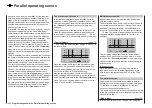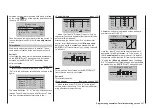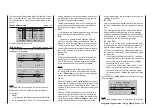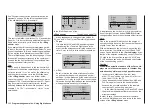
291
Programming examples - Winged models
Tail type
Motor at C1
Normal
Aile/flaps
2AIL
Model type
Brake Off
In 1
–90%
SEL
front
STO
This idle path ensures that all brake settings remain
at “neutral”, even with minor deviations from the limit
of the brake flap control. At the same time, the effec-
tive control path is automatically spread to 100 %.
For this reason, in the next step it must be ensured
that the influence of the C1 stick on the motor can be
influenced. For this purpose, switch to the menu …
»Phase settings«
… and assign a meaningful name, such as “Normal”,
from the list for “Phase 1” after activation of the selec-
tion field in the “Name” column. The asterisk in the
second column indicates which phase is currently ac-
tive. As long as no phase switch has been assigned,
this is always Phase 1. “Phase 2” can be given, ap-
propriate to the example, the name «Landing».
In the “ph.Tim” column you can assign a so-called
flight phase timer for the measurement of the motor
running time and/or the gliding times as necessary for
each phase. You could, for example, assign one of the
“Timers 1 … 3” to the “Normal” flight phase in order to
measure the total motor runtime via the C1 stick:
Pha1
Pha2
Pha3
Name
ph.Tim
Pha4
Pha5
normal
–
–
–
–
Clk 1
Landing
Then the timer is controlled through a corresponding
control switch to be defined on the C1 stick. As soon
as you switch to the “Landing” flight phase, this flight
»Model type«
Here you first specify in the “motor” line whether the
throttle minimum position (= Motor “OFF” position)
should be at the “front” or “back” – as already dis-
cussed: In the following programming example, “Mo-
tor OFF” and “Brake OFF” are combined at “front”:
Tail type
Motor at C1
Normal
Aile/flaps
1AIL
Model type
Brake Off
In 1
+100%
SEL
front
Note:
With the selection of “Throttle min front/back” the
trimming will then only have an effect in the “idle”
direction of the motor and is not the same as with the
“none” entry, having the same effect at every position
of the C1 stick. Since the C1 trimming is not normally
used with electric drives, however, this has no further
relevance.
You adjust the “Tail type” according to your model, in
this case “normal”.
In the “Aileron/flaps” line you enter the correct number
of aileron and flap servos – in this example “2 AIL”.
In the last line you leave the standard entries for the
selection of “Brake retracted = front”. On the other
hand, if the preference is for “Brake retracted = back”,
select the “Brake offset” line and define the offset
point – as described on page 105 – as “back”. In the
process, if the offset point is not placed completely
at the end of the control travel, the remainder of the
travel is “idle” up to this limit.
Control E-motor and crow alternately with C1 stick
Example 4
Before we discuss the programming of this fourth
example or turn to the expansion of the previously
described basic programming, a few words should be
said about the position of the throttle/brake stick with
“Motor OFF” or “Brake OFF”. Normally the C1 con-
trol stick is moved forward for the throttle control and
backward for the extension of the brake. However, if
for this type of “traditional” assignment, for example, a
switchover of the brake system is to take place for the
“Motor OFF” condition (stick “back”) then a switchover
to “full brake” would take place immediately after the
pre-set switchover time specified in the »Phase set-
tings« menu, and the opposite will take place when
“brakes retracted” is switched over to propulsion
causing the motor to switch over to “full power” within
this time range …
A “glider pilot” can make the best of this “Emer-
gency” – normally with “brake retracted = front” – by
switching to motor “ON” only if necessary so that
power decreases, if applicable (and hopefully not
forgetting to push the C1 stick “forward” again when
switching back). A typical “motor pilot”, on the other
hand, operates in the opposite manner, only switching
to the brake if necessary, etc. You can also combine
the “Zero point” of both systems to avoid confusion,
whereby a “glider pilot” would tend prefer the “front”
and a “motor pilot”, on the other hand”, would likely
prefer the “rear”.
Whichever the case may be, the
mc-16
HoTT and
mc-20
HoTT transmitters permits both variants.
In the following text, however, the combination of the
two “OFF” positions to “front” is assumed. However,
if you have a different preference, it is not a problem:
The only difference from the described version lies in
the logical selection of “Throttle min rear/front” and,
if applicable, of a corresponding brake offset in the
menu …
Содержание HoTT MC-16 Series
Страница 1: ...Programming Manual mc 16 mc 20 HoTT 1 en mc 16 mc 20...
Страница 27: ...27 For your notes...
Страница 53: ...53 For your notes...
Страница 61: ...61 For your notes...
Страница 65: ...65 For your notes...
Страница 71: ...71 For your notes...
Страница 103: ...103 For your notes...
Страница 107: ...107 For your notes...
Страница 111: ...111 For your notes...
Страница 133: ...133 Program description Dual Rate Expo Winged models Set the Expo values as necessary in the same man ner...
Страница 137: ...137 Program description Dual Rate Expo Helicopter models Set the Expo values as necessary in the same man ner...
Страница 155: ...155 For your notes...
Страница 165: ...165 For your notes...
Страница 201: ...201 For your notes...
Страница 229: ...229 For your notes...
Страница 231: ...231 For your notes...
Страница 261: ...261 For your notes...
Страница 265: ...265 For your notes...
Страница 301: ...301 For your notes...
Страница 327: ...327 For your notes...
Страница 328: ...328 For your notes...
















































